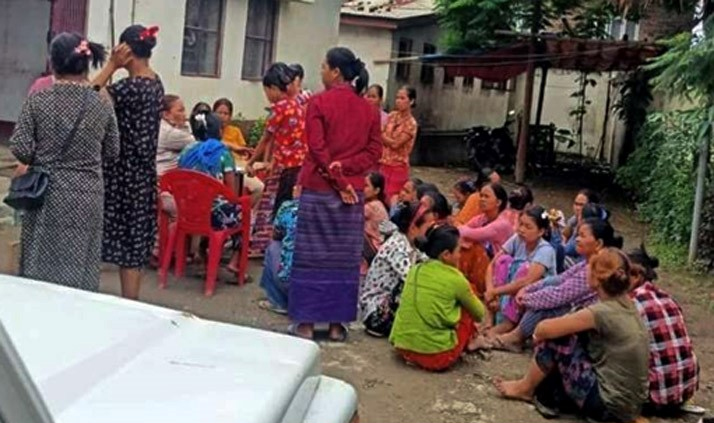
RAJKUMAR BOBICHAND
The United Nations Special Rapporteur on the Situations of Human Rights in Myanmar recommends that India give the United Nations High Commissioner for Refugees (UNHCR) unfettered access to refugees and asylum seekers throughout the country, including in Manipur and Mizoram States.
India is not party to the 1951 Refugee Convention or its 1967 Protocol and does not have a national refugee protection framework.
In the absence of a national and administrative framework for refugees, through its limited presence in New Delhi and Chennai, UNHCR is only able to focus on addressing refugee and statelessness challenges in those, albeit significant, areas. In Tamil Nadu, UNHCR’s absence from the camps limits the extent of the support it can provide for repratriation of Sri Lankan refugees. Elsewhere in India, UNHCR must rely on civil societies to moniotr refugee-related developments.
Recently, in Manipur fearing demographic imbalance, the six student organisations – AMSU, MSF, DESAM, KSA, SUK, AIMS – protesting on March 13 demanded the updating and implementation of the National Register of Citizens (NRC) in the state and the setting up of a Population Commission.
In a statement released on March 12, 2023, the six students’ bodies said there is unnatural population growth in the hills, new villages were emerging in reserved forest lands, and poppy plantations had spread to newer areas.
“The outsiders coming from the other side of Indian boundaries, especially Myanmar, are taking full advantage of possessing similar facial composition, skin colour, and language as they create and expand their own villages, encroaching land which is owned by the state on the hills of Manipur,” the statement claimed, adding that there was a “never-ending threat to the indigenous people of Manipur”.
The student leaders said there are large numbers of illegal immigrants who have entered Manipur recently through the porous border with Myanmar. New villages have come up in the hill areas with encroachment of forest land. There is also a threat from such illegal immigrants outnumbering the indigenous communities due to the unatural decadal growth rate of 39.54 per cent in the hills among tribal communities who absorb the illegal Myanmar nationals while the densely populated Imphal Valley has decadal growth rate of 15.72 per cent according to 2011 Census of India.
On the other hand, according to India Status of Refugees 2022 report, Mizoram had about 40,000 refugees from Myanmar and Bangladesh at the end of 2022. About 10,000 refugees entered Mizoram during 2022. In January 2022, more than 2,000 people reportedly entered Mizoram from Chin State of Myanmar. A headcount by the district administration in Champhai district found that 8,149 refugees from Chin state of Myanmar had crossed over to Mizoram in the last week of January 2022 and early February 2022 following incidents of “firing and bombing” in at least three Myanmarese villages. Further, another 589 refugees fled to Lawngtlai, Mizoram after Myanmar military following fresh armed clashes in Myanmar on 31 August 2022.
About 300 Chin-Kuki refugees belonging to 74 families from the Chittagong Hill Tracts of Bangladesh also entered Lawngtlai district of Mizoram. The Chin-Kuki refugees fled their homes due to arm clashes between Bangladesh Army and ethnic insurgent group Kuki-Chin National Army (KNA) in November 2022. The first batch of the Kuki-Chin refugees numbering 272 entered Mizoram on 20 November 2022, followed by 21 people in the second batch and another 15 people (third batch) fled to Lawngtlai district in December 2022.
Meanwhile, Thomas H. Andrews, UN Special Rapporteur on the Situation of Human Rights in Myanmar, on March 9, 2023 submitted his report, Situation of Human Rights in Myanmar to be tabled and discussed on March 20 during the ongoing Fifty-second session of UN Human Rights Council from February 28 to Macrh 31, 2023 at Geneva.
The Reports says, two years after Myanmar’s military launched an unconstitutional coup d’état and formed the State Administration Council, the country is in freefall. As opposition groups gain strength and the SAC’s control over territory and the people of Myanmar erodes, the military has doubled down on its brutal tactics, sowing violence and chaos across an ever-widening sphere of conflict. In recent months, the military has stepped up aerial attacks, bombing villages, schools, medical facilities, and encampments for internally displaced persons. The SAC’s campaign of mass arson continues, with roughly 58,000 homes and civilian structures burned since the coup. More than 1.3 million people have been displaced in the past two years, and more than 3,000 civilians have been killed.
The SAC continues to suppress all forms of dissent as it attempts to impose a military-dominated future on the people of Myanmar. More than 16,000 political prisoners are now behind bars. The SAC has sought to legitimize its efforts to crush civic space and control local and international organizations by establishing a draconian Organization Registration Law. Despite extending a nationwide state of emergency through July 2023, the junta continues to make plans to hold sham elections in a desperate attempt to claim legitimacy and gain international recognition, the Rreport said.
The humanitarian and human rights crisis in Myanmar has had a destabilizing effect on the region. Since the coup, hundreds of thousands of people have fled to neighboring countries in search of safety and opportunity. Countries and communities hosting refugees from Myanmar deserve credit for offering shelter and support to people who, in many cases, have been literally forced to run for their lives. However, considered in its entirety, the international community’s treatment of those fleeing Myanmar has been wholly inadequate. Myanmar nationals in neighboring countries enjoy few legal protections and face the risk of arrest, detention, deportation, pushbacks at land and sea, and obstruction of their access to UNHCR, refugee status determination, and resettlement. Higher income countries have failed to share responsibility for the crisis, offering paltry resettlement quotas and inadequate contributions to humanitarian relief programs, the Report asserted.
In this report, the Special Rapporteur calls on Member States to fulfil their obligations toward people from Myanmar by offering shelter and support, refraining from acts that endanger their human rights, and working towards durable solutions for refugees and other Myanmar nationals outside their country.
Government of India has also sought to prevent refugees fleeing violence and human rights violations from entering India. In March 2021, India’s Minister of Home Affairs ordered the Assam Rifles—a government paramilitary force responsible for security in India’s Northeast and the state governments of Nagaland, Manipur, Mizoram, and Arunachal Pradesh to “take appropriate action as per law to check illegal influx from Myanmar into India.” Five months later, in August, India’s Minister of State in the Ministry of Defence announced that 5,796 “Myanmar nationals/refugees” had been “pushed back.”
Myanmar refugees and asylum seekers have faced major barriers to accessing UNHCR and refugee status determination in many countries in the region. UNHCR does not have offices in northeastern India, meaning that Myanmar nationals entering Manipur or Mizoram must travel more than 2,000 kilometers to Delhi without documentation, risking arrest and detention, if they want to register with UNHCR, the Report mentioned.
Subnational policies and community practices often fill the gaps left by inadequate national and international protection. The Mizoram State government has acted unilaterally to issue ID cards to refugees and asylum seekers from Myanmar, providing protection against arrest and allowing them to move freely within the state.
The Mizoram state government has allowed children to attend government schools and has issued ID cards that help facilitate access to health care and employment opportunities, the Report said.
India has also detained refugees and asylum seekers from Myanmar. Many have been detained for two years or more. In January, authorities in Manipur State reportedly arrested approximately 81 people from Myanmar, charging them with illegally entering the country. In February, a Manipur court ruled that the detained persons are refugees and could not be deported. However, the group remains in detention and one detainee, a 32-year-old man, reportedly died in a detention centre in February.
Recently, Manipur Chief Minister Nongthombam Biren on February 24 said that there are a total 393 illegal migrants from Myanmar in Manipur of which 210 entered during 2022-23 while responding to a starred question of Sugnu MLA Kangujam Ranjit during the third session of the 12th Manipur Legislative Assembly. The Chief Minister also said that out of the 393 illegal migrants, one was deported, 107 are in judicial custody, 105 are at detention centres and 180 released on bails.
The Chief Minister said that 393 are identified illegal migrants but there are suspicious and unidentified illegal migrants in the state. As a means to identify, a biometric system has been opened at five districts for Aadhar house-to-house survey, Biren said, adding that it has started at Kamjong, Tengnoupal and Chandel districts.
Repsonding to Ranjit’s supplementary question if the migrants are detaind in refugee camps, the Chief Minister replied: “India is required to sign a charter for opening refugee camps to the UN. So, as a means to keep them, a detention centre has been opened in the state.” The Chief Minister also added that Assam Rifles are posted in border areas but they act more on insurgents. Therefore, the state government initiated to post police at 34 police outposts for security as well as to identify illegal migrants at borders.
Due to the unstable situation of neighbouring country Myanmar, the illegal entry might not stop. So, detention centres are opened in Tengnoupal and near Sajiwa jail, the Chief Minister informed. “Those illegal migrants in judicial custody are arrested under Foreigners Act. So, they are kept under judicial custody”, the Chief Minister added.
However, the exact data on the number of refugees from Myanmar taking shelter in Manipur is not available. The indigenous communities in Manipur particulalry the districts of Tengnoupal, Chandel and Churachandpur have the same ethnic roots as the families fleeing from Sagaing and Chin State in Myanmar. So it is hard to distinguish between refugees and locals. This also leads to ethnic tension as there is no official documentation of refugees and illegal immigrants from Myanmar fearing a demographic imbalance outnumbering the indigenous communities in Manipur.(This article was first published in the Imphal Review of Arts and Politics)
(The writer is a Senior Editor: Imphal Review of Arts and Politics)





